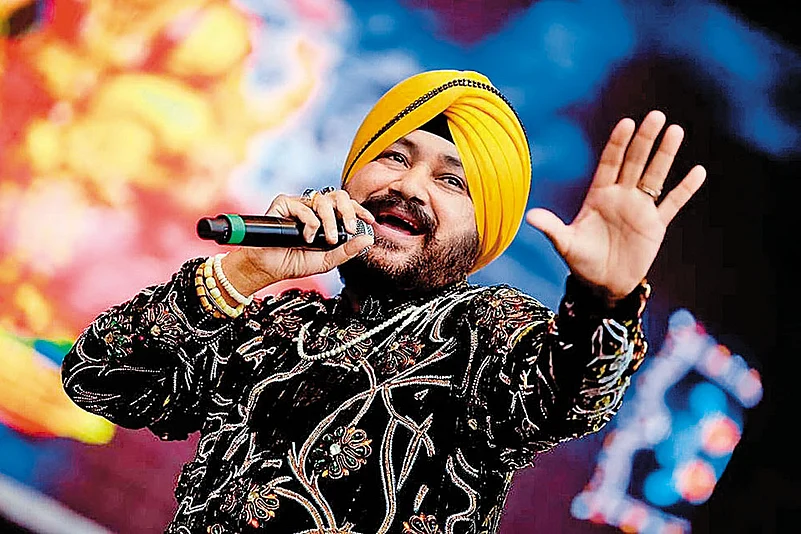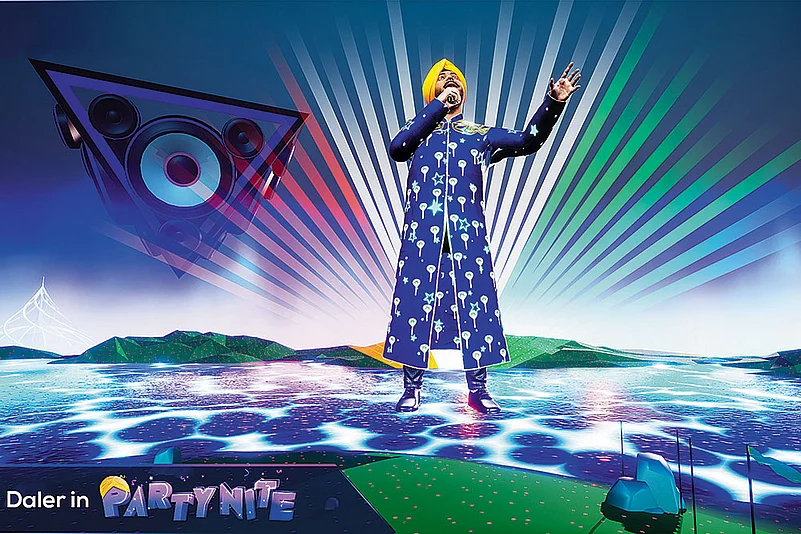In January 2022, Punjabi pop star Daler Mehndi organised a massive concert in India. Armed with a microphone and dressed in a navy blue kurta and his signature bejewelled turban, a bright yellow one this time, Mehndi stood and sang against a celestial purple and blue setting. In the thick of Covid-19’s third wave, he had close to 20 million people grooving to his beats in unison. But they were all safe, as was Mehndi. It was all done remotely—on metaverse.
While his avatar, or his online representation, looked little like him apart from resembling his flamboyant dressing style, his concert, India’s first on the metaverse, has ushered in a new time for Indian artists that transcends the boundaries of space.
With his concert, Mehndi joined the likes of Travis Scott, Justin Bieber, Marshmallow and Ariana Grande who have experimented with concerts on metaverse.
Moving beyond the fancy of mere cryptocurrency enthusiasts, the metaverse is beginning to become a playground for artists who are looking to test uncharted territories and unique ways to entertain.While the experience is currently confined to two dimensions of space, experiments to take to the third dimension are afoot globally, where AR and VR devices will transport digital avatars of artists to meet their fans – all in metaverse.
Several other Indian singers are also exploring ways to make the most of this new platform. In February this year, Bengali actor Vinita Chatterjee became the first female Indian artist to launch an original music video in metaverse. The song, Love You Mom, was launched on a metaverse platform called NextMeet, in addition to being released on YouTube.
“It (metaverse) is here to stay,” says Mehndi. “It has really picked up in the West, I am sure it will find fancy in India, too,” he adds.
Moulding the Metaverse Experience
The transition from real-life to digital events has accelerated, leading to the formation of nations of digital natives, says Rajat Ojha, the creator of PartyNite, the platform which hosted Mehndi’s metaverse concert.
“Artists or companies decide the culture, economics, and laws of the [virtual] land. They can ensure that they build a community of like-minded people,” says Ojha, adding that the company plans to rope in more artists into metaverse.
Several start-ups are helping artists get on the platform using augmented reality (AR) and virtual reality (VR). People are even going beyond concerts and videos, and entering the realm of artworks originally made for the physical world. Gurugram-based XR Central recently helped India Art Fair host its event on the metaverse by creating a browser-based 3D experience for the audience.
“Artists can use this powerful technology to tell stories about the masterpieces they have created. The virtual world will offer (the artists) a wider reach of audiences across the globe as the virtual studios will be created and owned by the artists themselves,” says Shrey Mishra, founder and director, XR Central.
Talking about the revenue stream, Mishra says that with metaverse, artists can not only sell physical art work but also a digital copy of their art as non-fungible tokens (NFTs). This opens up more revenue mediums for them. “Web 3.0—the third installation of the internet that metaverse is compatible with—will open up more revenue mediums for artists as technology matures with time,’’ says Mishra.
NFTs are digital assets that represent real-life objects on metaverse. These form a key component of the new space as they let the avatars, or people, buy or sell things in metaverse. NFTs of digital art have already started attracting an exorbitant amount of money from bidders on the blockchain, turning several digital artists into millionaires overnight.
Aparajita Jain, director, Nature Morte Gallery, has been running Terrain.Art, India’s first open NFT marketplace dedicated to art. Artists can sign up, mint and sell their NFTs using their platform. It usually costs anywhere from $4 to $200 to mint an NFT with Polygon and Binance on the lowest side and Ethereum on the highest side.
“Alongside working with artists who are familiar with NFTs, we have also been playing a pedagogical role in making artists and the wider audience aware of the importance of NFTs,” says Jain.
The Great Leveler
During the pandemic, social media platforms became a bridge between artists and their audiences to deliver and experience art in a new way. Web3, many believe, will only help bridge this gap further.
Singer-songwriter Raghav Meattle believes, “It will give upcoming artists the reach and opportunities to further their careers. Web3 is just the beginning of this revolution for the music industry.”
Apart from the metaverse, the emergence of AR and VR could also significantly impact art as we know it today. The reliance on middlemen like labels, agencies, etc. to raise funds to grow art is fast dwindling.
“In Web3, you no longer need to be paid in exposure—likes, comments, retweets—and can be paid in crypto and receive a fair passive income in royalties for the value you bring as a creator. You get to create art that matters to you and resonates with people who want to buy it,” says Mumbai-based musician Rishi Bradoo, who runs Swaraj Projekt, a platform for musicians using Web3 for more reach.
He also talks about the role of fans in such a setting and how it can be more engaging. “Artists can effectively build their own Creator DAOs (decentralised autonomous organisations) with their most involved fans. An artist-led Creator DAO, if structured well, can effectively replace a label or an agency,” the musician says.
Talking about autonomy, he says that a true metaverse was something that is still being built, one which would allow creators and fans to retain custody of their work.
Just a Fad?
Even when Mehndi feels that the space will only progress in India, he does not seem fully sold on the idea of going completely digital. “I will not take away from the charm of physical events. With Covid under control, we may get to enjoy the best of both worlds,” he says.
But there is one section of artists that is yet to be won over—the theatre artists. These artists, whose shows also went online during the pandemic, have been struggling to make their presence felt online.
Will metaverse and its rising popularity change that? Veteran theatre actor Sanjiv Chopra is not too optimistic. “The popularity of theatre in the metaverse will be directly proportional to how many young passionate theatre watchers participate there,” he says.
On the cost and technology aspect, Chopra belives that small artists, by themselves, would be incapable of directly getting into metaverse as they have limited resources and knowledge of emerging tech.
In the beginning, technical know-how and the costs for VR headsets may limit the space to only a few, but, in the future , the costs are only going to come down. In that hope, more and more artists are eyeing their spot in metaverse as they look for newer avenues to dominate.
***

Daler Mehndi’s Time To Rock In Balle Balle Land
Punjabi pop star Daler Mehndi seems to be on a record-setting spree. Not only was he the first Indian artist to perform in the metaverse, Mehndi is also reportedly the first Indian to buy a land parcel in the new digital realm. The singer even took his fans on a virtual tour of his metaverse land—Balle Balle Land—where he plans to host music concerts in the future.
“Lockdown has taught us the value of virtual. It has opened up newer formats and avenues for earnings,” says Mehndi in an interview with Outlook Business. Talking about his concert on the metaverse, Mehndi says that he could actually envisage the pipe dream coming true when PartyNite’s Rajat Ojha approached him with the proposal.
The singer feels that his early entry into the metaverse will be the “bastion” of his “legacy” and he also intends to nurture talent who will be able to benefit from the space. “I think it is the right time and I believe I will get the benefits of first-mover advantage. I will be able to develop this space into something that has long-term returns…it would be a shared growth for all involved,” he says.
As more and more artists look to mark their presence in the metaverse, it will not just be through NFTs, says Mehndi. His idea for investment in virtual real estate through Balle Balle Land seems to have born out of that thought. “Buying land is a far more lucrative option. Also, it is expensive. So, with time, the price will only appreciate…it is the best time to invest,“ says the popular singer.
With input from Shailaja Tripathi

















